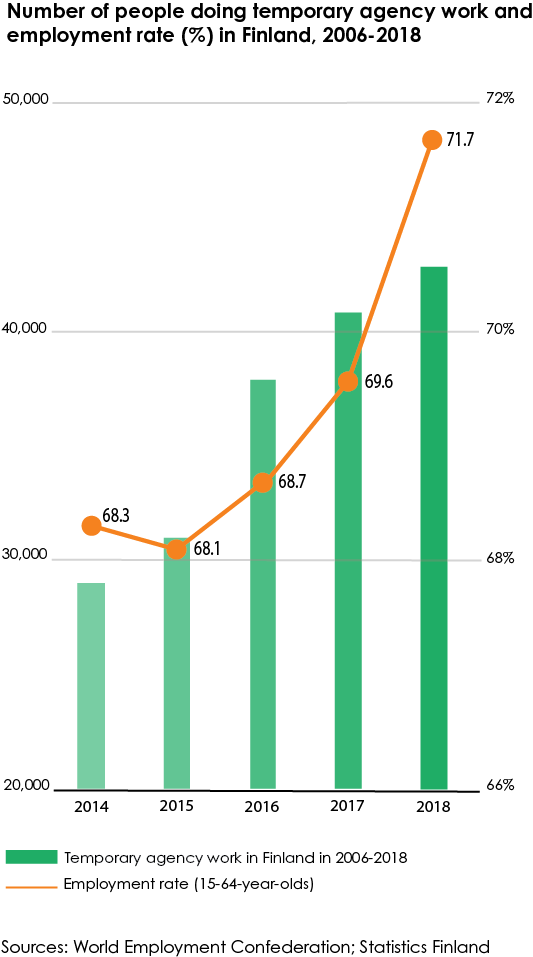
← Back
- Ideas and Insights
- Contemporary worklife
- Picking the best career opportunities
Cherry-picking the best career opportunities
Contemporary worklife, 24.4.2020
A freelancer, self-employed, temporary agency worker, part-time worker, on-demand worker... The popularity of e.g. these forms of work is increasing globally.
Unlike is often believed, flexible forms of working have not reduced the amount of traditional forms of working, but have, instead, emerged alongside them.
It could, therefore, be said that new forms of working have become more common at the cost of unemployment and not at the cost of traditional forms of working. This trend is also visible in Finland, where flexible forms of working have become more common at the same time as the overall employment rate of the working age population has evenly increased.
Those performing flexible work are satisfied with their career
It is typical of flexible forms of working that the workers can decide when and how much they work, and often also the location of the work, i.e. they can cherry-pick the best opportunities.
In most cases, flexible working is a conscious choice that fits the worker’s life situation or lifestyle. In 2018, only one third of Finns working part-time would rather choose full-time employment, according to Statistics Finland. The satisfaction rate is even higher in the United States, where a peer evaluated study published in 2019 shows that 80% of people performing flexible work are satisfied with their work. The aspects of flexible working that were considered the most pleasing include the opportunity to affect one’s own schedule and working hours. Therefore, new forms of working can be considered to offer a worthy alternative for many people seeking a more autonomous career.
However, the increased popularity of flexible working has also raised concern. Some of the flexible work is implemented outside traditional employment contracts and employment conditions. This is especially often the case with platform-based and task-based work. Multi-national companies based on a platform-based economy have been criticised in recent years for evading the rights of self-employed people and for wage dumping.
Temporary agency work combines flexibility and security
Flexible work can also be responsible: temporary agency workers are in an employment relationship with the temporary work agency and have the same pension and occupational healthcare benefits as any other wage earner. However, they can draw up their work schedule based on their personal preference, and can even work full-time or on a long-term basis, if they so choose.
Similar to other forms of working, temporary agency work offers young people who are only starting their career an opportunity to gain work experience and enhance their professional skills. Temporary agency work also offers an opportunity for many unemployed job-seekers to get back into working life.
However, it should be noted that today, the opportunities offered by temporary agency work are diverse and it is no longer synonymous with physical work. With the rise of interim management solutions, a director or an expert can also be acquired through a temporary work agency.

The use of temporary agency workers has increased evenly in Finland over the past five years. In 2018, roughly 2% of Finnish wage earners worked through temporary work agencies. In other words, temporary agency work is still a relatively marginal form of working in Finland. Of European countries, temporary agency workers are used the most in Great Britain, where the corresponding figure was 5.1 %, and in the Netherlands (3.3 %).
The flexibility of traditional working is also increasing
On the other hand, flexible work can mean a traditional employment relationship where the combining of work and leisure time has been made more flexible. In this, Finland is among the leaders in the world, as the option to work flexible hours has been included in the law for over 20 years! At the beginning of 2020, the Working Hours Act was extended even further, allowing full-time workers to decide the location where they work more freely.

The popularity of the new and diverse forms of working has increased rapidly in recent years and offer an alternative to traditional employment relationships. At the same time, traditional forms of working have maintained their popularity, but they have also adopted influences from flexible employment relationships. It could be said, therefore, that strict boundaries between the various forms of working are disappearing.
It is important that the moving of labour between various employment relationships and forms of working has also been observed in legislation.
This article was firts published in StaffPoint White Paper 2020: Giving Positive Spin to Worklife. Download the free publication.